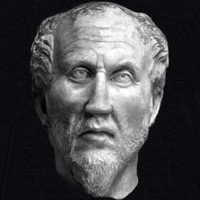Plotinus' Conception "On the Intellectual Beauty"
Plotinus, the neo-Platonic philosopher challenges Plato's theory that art imitates nature/world of appearances and is thus twice removed from reality. He gives art a higher position in his system. Plotinus develops the Platonic distinction between the world of appearance and true reality and takes art as an emanation from the ultimately unknowable "One".

Plotinus (204-270)
The "One" is the primal ground of all being and the source of value that is expressed in a triad of the Good, the Intellect and its knowledge, and the All-Soul. Everything emanates from the One; the nature of reality is an expanding series of concentric circles, each dependent on the one within it, and all produced by the spilling over of the eternal One; and everything strives to return to it. Oneness disintegrates into multiplicity, unity into individuation. Beauty, as Plotinus laboriously defines it, is central to his system, since the more beautiful a thing is, the closer it is to the "One". Sheer symmetry is not necessarily a sign of beauty.
Plotinus concentrates on the idea that the artist is the creator. Nature is incomplete and it is the artist who takes raw materials from nature and imposes form, which is beautiful and finally reshapes it by offering newness. This ability comes from within the artist who is capable of adding what nature is lacking. For, Plotinus artist does not possess any rational mind rather he possesses intuitive force, through which creation of art is possible.
The beauty of the artist's creation lies not in any physical object that it copies or that it shapes, but in what the artist imposes on his materials. In the imposition, the artist turns his materials into something other than what they were, makes them into a new form: this attainment comes from within the artist, who is capable of adding where nature is lacking. To say it more clearly, Plotinus argues that the artist enjoys an especially close participation in the divine Reason, for not only is he sensitive to the Beauty which the natural world reflects by imitation, he is also one who fashions beauty, improving upon nature itself. Plotinus implies that there is a struggle between the artist and his materials, and that in the successful work of art materials are partly subdued. When this occurs, the form, in the artist's mind, which is derived from intellect and ultimately from the one, is given some visible expression.
Plotinus' emphasis on unity and its centrality in reference to natural or artistic beauty gives a microcosmic significance to every experience of the beautiful. The beauty of any whole seems to depend collectively on the beauty of its parts, yet the beauty of those assembled parts consists, not in their respective qualities, but in the way they work together to produce a total comedy. And an artist strives to come near to this totality and his involvement in artistic activity is an example of that struggle. Plotinus considers the artist a creator of vehicles of valuable, though imperfect, spiritual insight. His artist does not work by rational principles; he does not lead us to the ideas through the use of reason. He tries to express in an artistic medium some insight into the "One". In this expression there lies the intellectual beauty. A celebrated example further sheds light on Plotinus' concept of what artistry can do. He compares an untreated block of stone and a finished work of sculpture. One is untouched by art; the other has been wrought by the craftsman into a beautiful statue. The stone thus brought under the artist's hand to the beauty of form is beautiful not as stone, but in virtue of the form or idea introduced by art. Therefore, the art itself is capable of introducing an idea in the raw materials that it handles and the idea that is generated by the intellect of the designer adds beauty to materials.
When artist convert the stone into an image, 'One' is constantly thrown down to the matter. During this an artist comes with soul, intellect and skill to lift 'One' up to the level of perfection. Artist start struggling with the matter, while struggling, he uses three things 'intellectual principle' brought from the intellect, 'emotion' from soul and skill too. When he starts shaping the matter (stone) cutting with skill and putting intellect and knowledge, along with emotion and soul make the stone shift upward to 'One'. The artist generates this art as 'One' with sparkle and this beautiful sparkle which Plotinus called is intellectual beauty.
Here Plotinus varies on Plato's idea in the sense that Plato claims artist as a slavish imitator but Plotinus opines artist to be the creator. Plotinus has announced the art whereas Plato denounced the art.
